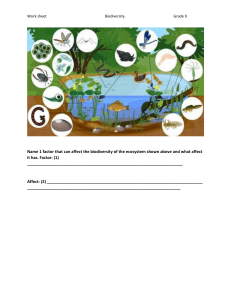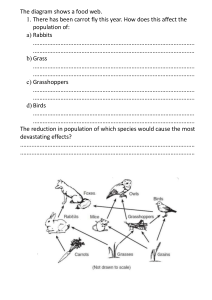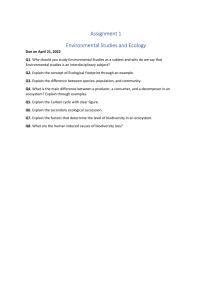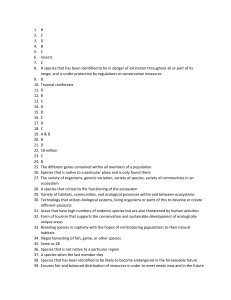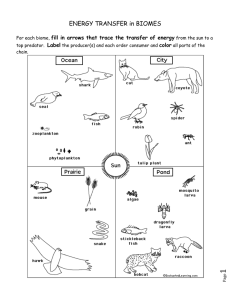Ecology & Biodiversity: Notes on Ecosystems & Conservation
advertisement
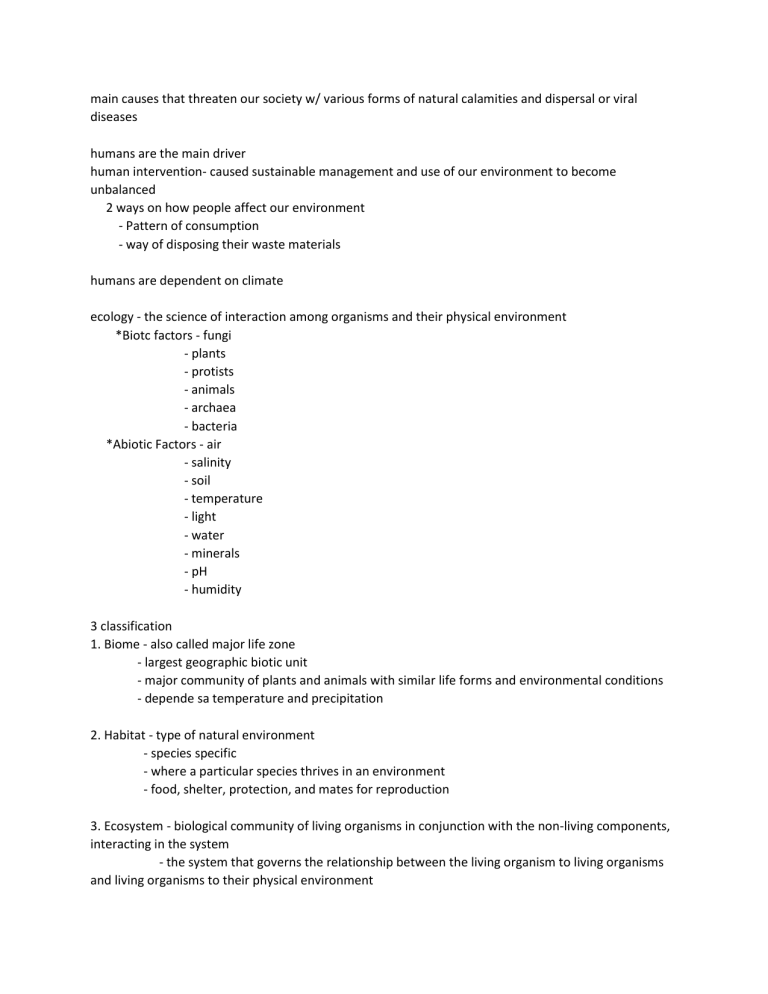
main causes that threaten our society w/ various forms of natural calamities and dispersal or viral diseases humans are the main driver human intervention- caused sustainable management and use of our environment to become unbalanced 2 ways on how people affect our environment - Pattern of consumption - way of disposing their waste materials humans are dependent on climate ecology - the science of interaction among organisms and their physical environment *Biotc factors - fungi - plants - protists - animals - archaea - bacteria *Abiotic Factors - air - salinity - soil - temperature - light - water - minerals - pH - humidity 3 classification 1. Biome - also called major life zone - largest geographic biotic unit - major community of plants and animals with similar life forms and environmental conditions - depende sa temperature and precipitation 2. Habitat - type of natural environment - species specific - where a particular species thrives in an environment - food, shelter, protection, and mates for reproduction 3. Ecosystem - biological community of living organisms in conjunction with the non-living components, interacting in the system - the system that governs the relationship between the living organism to living organisms and living organisms to their physical environment *it changes over time and affected by the natural laws, volcanic eruptions, floods, fires, and by human activities Extinction - cause an entire species to permanently disappear several causes: asteroids climate change loss of habitat invasive species lack of food pollution lack of genetic diversity human predation disease better-adapted competition 2 classifications of ecosystem *terrestrial ecosystem – exclusively land-based ecosystems (forests, grasslands, tundra, desert, savannah) *aquatic ecosystems - freshwater ecosystems (streams, rivers) - marine ecosystem - high salt content and greater biodiversity autotrophs - produce their own food from energy heterotrophs - eat other plants or animals producer - able to produce their own food primary consumers- herbivores secondary " - depende on primary consumers tertiary " - depend on secondary quaternary " - top of the food chain - have no natural predators saprophytic - recycle nutrients to be used by plants - thrive on the dead and decaying organic matter species - group of similar individuals - capable of exchanging genes thru interbreeding taxonomy - nomenclature of naming, describing and classifying organisms - domain, kingdom, phylum, class, order, family, genus, species *binomial nomenclature - carl linnaeus category of species keystone species - helps define an entire ecosystem - has large impact on the ecosystem flagship species - charismatic - acts as an ambassador, icon, symbol for a defined habitat umbrella species - selected for making conservation-related decisions Biodiversity - variety within and among living organisms *can be measured in terms of genetic diversity, species richness, endemic species, ecosystem diversity importance of biodiversity - genetic diversity - protect freshwater resources - speed recovery from natural disasters - maintaining balance of the ecosystem - sustainability and growth - provision of food security - adaptation to different habitats - provision of biological resources - promote soils formation and protection - maintain food chain in the nature conservation management system (CMS) - procedure for maintaining a species or habitat (IUCN) Red List of threatened species -world's most comprehensive inventory of the global conservation status of biological species - uses to evaluate the extinction risk - aim is to convey the urgency of conservation issues Red List Categories extinct extinct in the wild critically endangered endangered vulnerable near threatened least concerned data deficient convention on international trade in endangered species of wild fauna and flora - regulates the international trade of wildlife and wildlife products - with 183 party governments different level of protection from trade Appendix I - includes species that are in danger of extinction because international trade Appendix II - includes species that aren't facing imminent extinction but need monitoring to ensure that trade doesn't become threat Appendix III - includes species that are protected in at least one country, when that country asks others for help regulating the trade Facts about the Philippines - one of the 18 mega biological diverse countries - 2/3 of the earth's biodiversity - 5% of the world's flora - species endemism is very high - one of the world's biodiversity hotspots - one of the top conservation areas One Health - holistic approach to designing and implementing programs, policies, legislation and research in w/c multiple sectors communicate and work together to achieve better public health outcomes - areas of work include food safety, control of zoonotic diseases, combatting antibiotic resistance Information in influenza viruses - election of viruses for human vaccines drug-resistant microbes novel human pathogens one health approach draws awareness on the links between biodiversity, which signals a health ecosystem, and human and animal health
